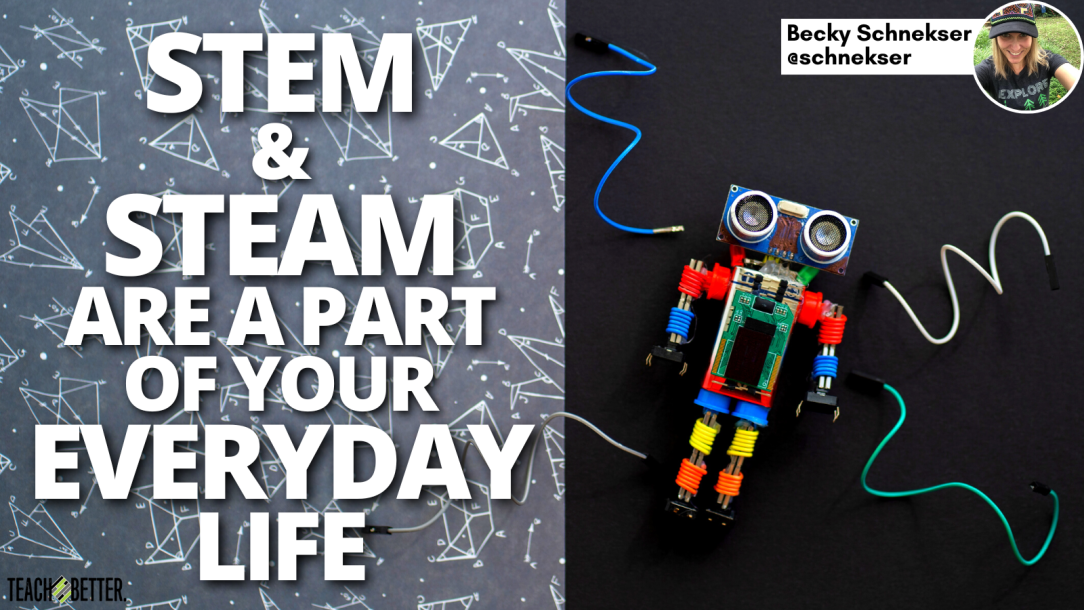TL;DR:
- STEM and STEAM are integral to our everyday life and we encounter many challenges that require these skills.
- STEM stands for Science, Technology, Engineering, and Mathematics, while STEAM adds Art or Architecture.
- A problem with a door latch at home is an example of STEM and STEAM in action, involving science, technology, engineering, art/architecture, and mathematics.
- We can intentionally use examples of STEM and STEAM in the classroom to make learning more meaningful and authentic to learners.
SURPRISE and welcome to “life” where nearly everything we do, every moment, every encounter, and every challenge of the day is STEM or STEAM based.
For those unfamiliar or in need of a quick refresher, the acronym STEM stands for Science, Technology, Engineering, and Mathematics. We often, especially in the world of education, see STEAM, which in some cases adds the element of Art or Architecture. Whether you are on team STEM or STEAM, or maybe unsure about this whole idea, I am here to help you unpack. Let’s break this down together.
What if I told you, your everyday life consists of near-constant STEM and STEAM challenges?
Think about this for a moment. STEM and STEAM are integral to your everyday life. How many problems or challenges do you encounter every day? I’ll answer this for you…a lot. You might not even realize how many ways you adapt during the day to meet the challenges you encounter, and the role that STEM and STEAM play in those decisions. It’s literally a part of being human.
For example, this morning, the back door to my own house would not latch or lock. This is a classic STEM or STEAM challenge popping up in my life.
STEM and STEAM are integral to your everyday life. How many problems or challenges do you encounter every day? I’ll answer this for you...a lot. Click To Tweet
Ready to unpack this with me?
I do not want to leave my home unlocked for the day, so I investigate the lock and latch itself to see what I can do in the next 2–3 minutes to temporarily solve the problem. That will allow me to go to work today with at least some peace of mind. The latch and lock are not lining up the way they should. I lift the door handle and door slightly and at the same time latch the lock securely into its destination. The door locks, success for now at least. Long term, this will cause stress on the door frame, hinges, and the locking mechanism itself, so I will need a better solution soon.
When I return home later today, I will test the lock again to see if the temporary solution is still working then devise the next steps of a solution that will be long-term. I will inspect the hinges of the door to see if they need to be tightened or replaced, and inspect the door frame to see if it remains secure or if pieces have loosened contributing to the door not latching and locking properly.
Based on these observations, I will be able to design the next steps of my long-term solution. I may need to replace the locking mechanism completely. I may need a new door, frame, maybe even both. Ah, the beauty of being a homeowner, am I right? This is where measurement and calculations will surely come into play, maybe even a little budgeting of money.
[scroll down to keep reading]
Do you see the pieces of STEM and STEAM here?
Science
Investigating the locking mechanism and condition of the hinges, door, and frame, as well as thinking of possible environmental contributors that may cause this problem are all pieces of the science component of this situation. This could easily be woven into an investigation on simple or complex machines or other physics concepts.
Technology
Whether I am using hand tools like a screwdriver, using a tutorial or article from the internet, or taking apart and/or installing a new locking mechanism on my door, these are technology components.
Engineering
In my own thinking about this situation, designing solutions, and working through possible solutions, I am practicing skills of engineering. I have been thinking critically and creatively throughout the process and will undoubtedly need to troubleshoot my ideas and solutions as I work my way through this challenge.
Art or Architecture
In working with a door, door frame, and mechanical components of a door latch, architecture, and design are involved. The overall design of the door latch and it components are a part of the process overall. I could also investigate artistic design elements or embellishments that may be a part of the door, locking mechanism, or hardware.
Mathematics
I will need to measure different components of the door and latch as well as check the angles of the door and its frame as a whole to inspect their possible role in the door’s inability to latch. It is also possible that I will need to purchase new parts in order to solve my problem. I will need to calculate the cost and determine what pieces and models I can afford.
What other problems do we face daily that are actually STEM or STEAM elements? How can we use these examples within our classrooms intentionally? How might we use examples like this or things that happen during class to make learning more meaningful, relevant, and authentic to our learners? This example from home happens anywhere there are doors with locking mechanisms or just doors in general. What about door openers or doorstops?
Now that I think about it, the doorstop to a common area in my school has been rendered useless. It is taped up onto the door itself while it has been damaged. Could I use that with my learners? Absolutely…and you know what…I will!
About Becky Schnekser
Becky is an educator explorer with experience in PK-5, public and private, all subject areas. Currently, she prides herself on teaching field and expedition-style science to K-5 explorers in Virginia. Her passion resides in authentic experiences to educate learners of all ages and all subject areas. When not with young scientists in the field, she spends time around the world completing fieldwork with scientists in places like the Peruvian Amazon, Galapagos, and Iceland.




